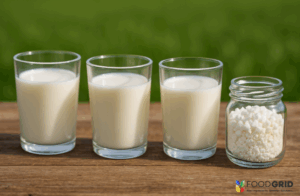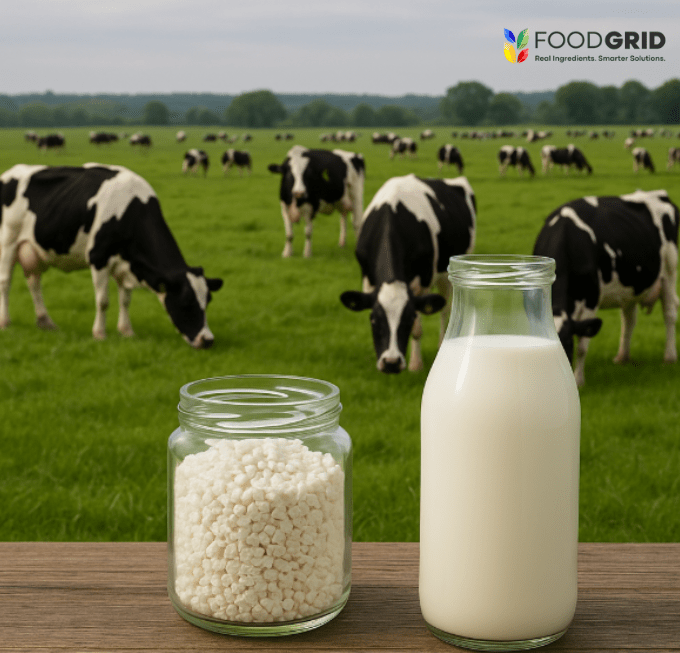In a modern dairy operation with 500 + cows, each day of underperformance in early lactation costs tangible revenue. What if a targeted inclusion of rumen-protected calcium salts of fatty acids — at 3-6% of dry matter — could reliably increase milk yield by 2-4 kg/day and lift milk fat content by up to 0.8%? The latest research shows that this is not wishful thinking—it’s achievable. For you, the herd nutritionist or farm manager with a $50K-$200K additive budget, CSFAs may be one of the highest-leverage toolsets in your ration toolbox.
Introduction
As a dairy nutritionist (let’s call you “LactaMax Optimizer”), your mandate is clear: maximise milk yield and fat content, improve energy balance and herd health, and ensure that your bulk additive spend delivers measurable ROI. In early lactation, high-yield cows face severe energy deficits, variable dry matter intake (DMI), and rumen pH variabilities — all of which challenge production, components and metabolic health. To wrestle these issues, many operations are increasingly turning to rumen-protected fat sources — most notably calcium salts of fatty acids (CSFAs). These compounds can deliver concentrated energy, bypass much of rumen bio-hydrogenation, and support milk and component performance reliably.
In this blog we review the latest science on CSFAs for dairy cows: dose-response, fatty acid profile optimization (palmitic vs oleic), performance outcomes, practical implementation in 500 + cow herds, supplier contracting/bulk buying, and monitoring for ROI. We link to our company resources at FoodGrid Inc. and invite you to explore additional articles in our FoodBlog archive. Note: this content is unique and does not duplicate previous blogs on our site.
Why CSFAs Are a Strategic Feed Additive
Addressing the Early Lactation Energy Deficit
During early lactation, dairy cows often experience a negative energy balance: intake is constrained, mobilisation of body fat is triggered, and risk of metabolic disorders rises. Conventional fat sources may interfere with rumen fermentation or become fully hydrogenated before absorption. CSFAs — fatty acids bound to calcium salts — remain more inert in the rumen, can bypass microbial hydrogenation to a large extent, and deliver fatty acids to the small intestine for absorption. This delivers more usable energy to the cow while minimising rumen upset.
Milk Yield and Component Response
Peer-reviewed meta-analyses demonstrate that inclusion of CSFAs in dairy diets leads to consistent improvements in milk yield and fat content. For example, a meta-analysis of calcium salts of palm fatty acids (CSPF) found clear yield and component advantages versus non-fat control diets. Journal of Dairy Science+1 For a nutritionist evaluating bulk contracts, that kind of consistency is exactly what you need.
Rumen Health Compatibility
Because CSFAs are relatively rumen-inert, they offer high-energy inclusion without significantly disrupting rumen pH or fibre digestion — provided the base ration is well managed. For herds with variable rumen pH, CSFAs represent a more stable energy delivery mechanism than high-free-oil supplements.
Regulatory and Herd Health Context
With increasing regulatory scrutiny on antibiotics and a focus on sustainable herd health, CSFAs provide a nutritional alternative rather than a pharmacological one. They support improved energy balance (reducing risk of ketosis, fatty liver) and healthier reproduction outcomes, without regulatory burdens associated with antibiotic-based interventions.
Recent Research: Key Findings for CSFA Use
Dose-Response of CSPF in Dairy Cows
A study examining increasing levels of calcium salts of palm fatty acids (CSPF) in early lactation found that higher levels improved nutrient digestibility and production responses in dairy cows. ScienceDirect The practical implications for your herd: inclusion position matters (3–6% DM appears in the sweet zone) and you should monitor digestibility metrics as well as yield.
Palmitic vs Oleic Ratio Matters
A recent study in the Journal of Dairy Science compared CSFAs with different palmitic (C16:0) to oleic (C18:1) ratios. The findings showed that cows fed higher oleic ratios (within CSFA form) had improved nutrient digestibility and component yields compared to those fed high-palmitic versions. Journal of Dairy Science+1 For you buying in bulk, this means the supplier’s fatty acid profile is not just a marketing line—it’s a technical spec that impacts ROI.
PUFA-Enriched CSFAs and Reproductive/Metabolic Performance
A 2025 open-access study evaluated CSFAs derived from a mixture of linseed and fish oil (rich in omega-3 fatty acids) in early-lactation dairy cows. It reported improved milk yield, protein yield, and improved reproductive parameters. MDPI For a herd of your size and complexity, these additional benefits around reproduction and health add meaningful value beyond just milk yield.
Meta-Analysis Confirms Consistency
The meta-analysis on CSPF confirms consistent positive responses in milk yield and fat yield across a broad set of studies. Journal of Dairy Science For a 500-cow plus operation, consistency equals reliability—your contracts and budgets rely on that.

Performance Targets: What You Can Expect
For a 500 + cow dairy operation with a deliberate nutrition strategy and a bulk CSFA inclusion plan (3-6% DM), here are performance benchmarks you can reasonably target:
- Milk Yield Increase: +2-4 kg/day per cow when CSFA is properly included and other ration parameters are optimized.
- Milk Fat Content Increase: Up to +0.8 percentage points under favourable conditions (e.g., from 3.6% to 4.4%).
- Improved Feed Efficiency: With CSFAs delivering more usable energy, cows convert feed to milk more effectively, improving energy‐corrected milk (ECM) and body condition retention.
- Improved Metabolic Health: Reduced risk of ketosis/fatty liver, improved energy balance metrics, fewer culls for metabolic failure.
- Enhanced Reproduction (secondary): In trials with omega-3 enriched CSFAs, conception rates improved.
- ROI Justification: With incremental yield and component gains, the bulk cost of CSFA pellets or pallets can be amortized quickly given your additive budget of $50K-$200K.
Example: A 1,000‐cow herd implements CSFA at ~4% DM for the first 100 days in milk and averages +3 kg/day milk yield and +0.5% fat. With milk priced at $0.34/kg and fat bonus incremental value accordingly, the yield and fat gains can justify a CSFA cost of ~$0.08-$0.12 per cow per day easily.
Implementation Strategy for Your Herd
Product Selection & Supplier Criteria
- Confirm that the product is truly a calcium salt of fatty acids (CSFA), not simply a free oil or blend.
- Request formal analysis of fatty acid profile: palmitic (C16:0) and oleic (C18:1) proportions, and any other significant long chain fatty acids.
- Verify rumen protection data: look for peer-reviewed studies or supplier data showing minimal negative impact on rumen fibre digestion, DMI or milk fat stability.
- Ensure supplier can deliver in bulk format (1-ton pallets or equivalent) and is stable for large‐scale operations.
- Examine contract terms: require batch certificates, guaranteed fatty acid profile, and optional performance benchmarking.
- Look for a supplier that offers technical support for ration inclusion, mixing protocols, and monitoring (e.g., Valudor, Megalac equivalents).
- Include a clause around product viability under variable rumen pH conditions (which you know is an issue in your ration environment).
Diet Design & Inclusion
- Set target inclusion range at 3-6% of DM in the total diet. For example, if your cows consume 24 kg DMI, 3% is ~0.72 kg CSFA; 6% is ~1.44 kg.
- Focus inclusion especially during early lactation (first 90–120 DIM) when energy deficits are greatest and component response is highest.
- Ensure your base ration supports rumen health: good forage quality (adequate NDF and digestibility), stable rumen pH, consistent feed delivery, and proper bunk management. The performance benefit of CSFAs is maximized when rumen conditions are stable.
- Monitor DMI and ensure you are not compromising intake by shifting too much energy to fat without feeding adequate fibre.
- Mix CSFA carefully into the TMR or partial TMR so that each cow receives accurate dose—bulk operations can use palletised product and feed-in rate control.
Monitoring & Performance Evaluation
- Track milk yield per cow, milk fat %, milk fat kg/day, milk fat yield, milk protein % and yield, and feed efficiency (ECM per kg DMI).
- Calculate incremental revenue: yield gain × milk price + component bonus minus CSFA cost per cow per day.
- Monitor herd health metrics: BCS change, NEFA/BHBA (if available), incidence of ketosis/fatty liver, culling rate for metabolic disorders, days to first service, conception rate.
- Review quarterly with supplier: performance vs expectation. Use your internal KPI dashboard to compare pre- and post-CSFA implementation periods.
- Maintain documentation of inclusion rates, fatty acid profile from supplier, batch certificates, herd performance changes, and profitability impact.
Budgeting & Supply Chain
- With an annual additive budget of $50K-$200K, negotiate volume pricing and flexible contract terms tied to performance metrics.
- Approach suppliers early to lock in pallet deliveries for the high-risk early lactation period (winter/spring or calving peak).
- When budgeting, include cost of mixing/integration, monitoring time, and potential incremental returns so you present the case to farm management and finance.
- Include contingency planning: if rumen pH becomes unstable or forage quality drops (which impacts CSFA performance), the ROI drops—so plan for dual strategies (CSFAs + rumen buffer + high-quality forage) rather than a single-lever fix.

Addressing Common Challenges
Variable Rumen pH and Stability
Your herd may already experience episodes of low rumen pH due to high starch or variable feeding times. CSFAs perform best in a stable rumen environment. While CSFAs are rumen-protected, they are not immune to poor rumen conditions. For best effect: ensure consistent feeding times, adequate forage fibre (NDF > ~28–30%), consider rumen buffers (e.g., sodium bicarbonate), and monitor rumen health parameters. Without rumen stability, CSFA results may be muted.
Cost Pressure and ROI Justification
With feed costs rising, you need additive spend to show clear return. Building a cost‐benefit model before implementation is essential. Use conservative estimates (e.g., +2 kg milk/day, +0.4% fat) and calculate pay‐back period and incremental income. Present to stakeholders (farm manager, feed purchasing) as a strategic investment rather than an optional line item.
Supplier & Specification Risk
Not all CSFAs are created equal. Differences in fatty acid profiles, rumen protection, pellet vs powder, mixing behaviour, and supplier quality matter. Insist on full fatty acid profile data, batch certificates, and ideally on-farm trial data or peer-reviewed studies. Avoid ambiguity: if the product description is vague (“rumen bypass fat”), get into the details (palmitic/oleic %, calcium content, mixing inclusion rate). Your budget magnitude (bulk buying) means supplier performance matters.
Integration with Herd Health Strategy
CSFAs are powerful, but they are not a substitute for comprehensive herd nutrition and health management. Ensure that your foundation is solid: quality forage, adequate fibre, proper mineral balance (Ca:P ratio, DCAD for transition cows), and metabolic monitoring. CSFAs augment energy delivery—but do not replace rumen or metabolic health infrastructure.
Summary Takeaways for the Herd Nutritionist
- Calcium salts of fatty acids (CSFAs) are a scientifically-validated tool to increase milk yield (+2-4 kg/day) and milk fat (up to +0.8%) when included at 3-6% of diet DM in high-yielding dairy cows.
- Fatty acid profile matters: blends with higher oleic acid (C18:1) appear to support better digestibility and component yield than purely palmitic (C16:0) formulations.
- For a 500 + cow herd and additive spend of $50K–$200K, CSFAs can deliver strong ROI—provided ration design, rumen health and monitoring are rigorous.
- Implementation requires carefully selected product, bulk supplier contracting, mixing and inclusion discipline, consistent monitoring of key KPIs (yield, fat %, health metrics) and integration with your broader herd nutrition strategy.
- Address ops-level risks: rumen pH instability, forage quality variability, mixing errors, supplier specification gaps. Mitigate via rumen buffers, forage management, batch verification, and performance contracts.
- CSFAs align with sustainability, metabolic health, and regulatory trends away from antibiotic interventions—reinforcing your position as the strategic nutrition leader for your operation.
Internal Links & Further Reading
- For an overview of how we approach feed additive value and supplier integration, see our main site at FoodGrid Inc.
- For deeper insights into feed additive strategies, milk component optimisation and herd performance, explore our blog archive at FoodGrid FoodBlog
- For a complimentary CSFA specification and herd performance checklist, contact our technical team via the Contact page on our website.
If you’re managing a mid-to-large dairy herd and seeking a high-leverage additive that delivers measurable milk yield, fat content and herd health returns — let’s talk. Reach out to the team at FoodGrid Inc. today to review CSFA product options, evaluate fatty acid profiles, set inclusion strategies, and build a performance-based contract tailored to your 500 + cow operation. Unlock higher yield, improved components and sustainable profitability from your additive investment.
References
- Roszkopf et al. “Effects of Feeding Calcium Salts from a Mixture of Linseed and Fish Oil on Productive Response, Metabolic Status, and Reproductive Parameters in Early-Lactation Dairy Cows.” Dairy (MDPI) Vol. 6 Issue 4 (2025). MDPI
- “Effects of the palmitic-to-oleic ratio in the form of calcium salts of fatty acids on nutrient digestibility and cow performance.” Journal of Dairy Science (2024) — ScienceDirect. Journal of Dairy Science+1
- “Effects of calcium salts of palm fatty acids on nutrient digestibility and production responses of lactating dairy cows (meta-analysis).” Journal of Dairy Science (2021) — ScienceDirect. Journal of Dairy Science+1
- “Effect of sources of calcium salts of fatty acids on production, nutrient digestibility, energy balance, and carryover effects of early lactation grazing dairy cows.” ScienceDirect (2016). Scie
